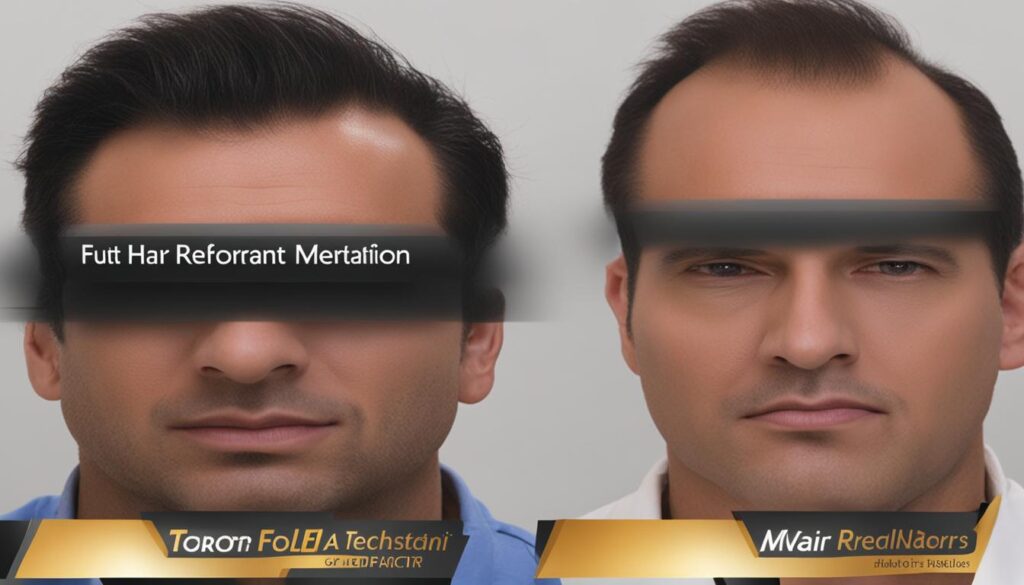Imagine looking in the mirror to see a vibrant, rejuvenated reflection staring back at you, complete with the fullness of hair you once knew. That’s the promise—and reality—provided by FUT Hair Transplant, an advanced solution paving the way for individuals to restore hair fullness and embrace the natural-looking hair transplant results they deserve. This gentle and meticulous technique heralds not just a renewal of hair but the rebuilding of confidence and self-perception.
Key Takeaways
- FUT Hair Transplant offers a definitive path to restoring hair density and aesthetics.
- Technological advancements assure natural-looking results aligning with individual expectations.
- Understanding the mechanics of the procedure empowers candidates to make informed decisions.
- A seamless journey from initial consultation to post-operative care is integral for success.
- FUT provides a potent solution to reclaim not only your hairline but also your self-assurance.
Understanding FUT Hair Transplant
The evolution of hair restoration techniques over the years has brought us to a sophisticated and refined method known as the Follicular Unit Transplantation (FUT) procedure. Before delving into the specifics, it is essential to understand the breakthroughs this method provides in the realm of hair transplantation.
What is FUT Hair Transplant?
A FUT hair transplant is a type of surgical hair restoration procedure in which a strip of hair-bearing skin is removed from a donor area, typically from the back of the head. The strip is then meticulously dissected into individual follicular units under microscopic guidance, ensuring each graft comprises natural groupings of hair follicles, ready to be transplanted to the thinning or bald area.
The Procedure of FUT Hair Transplant
The FUT procedure starts with local anesthesia to numb the donor site, followed by the surgical removal of a strip of scalp. The incision is carefully closed, leaving a linear scar that is typically concealed by the patient’s existing hair. Next, skilled technicians prepare the grafts, while the surgeon creates tiny incisions in the recipient area, mimicking natural hair growth patterns for seamless integration.
The Difference Between FUT and FUE
When comparing FUE vs FUT, it is important to recognize each technique’s unique characteristics. FUE, or Follicular Unit Extraction, differs from FUT by individually extracting each hair follicle from the scalp using a small punch tool. This method leaves numerous tiny scars scattered across the donor area but does not create a single linear scar.
| Feature | FUT Procedure | FUE Procedure |
|---|---|---|
| Method of extraction | Strip of hair-bearing skin removed | Individual follicles extracted one by one |
| Scarring | Single linear scar | Multiple small, round scars |
| Suitable for | Patients requiring numerous grafts | Patients with shorter hairstyles, or if donor area is limited |
| Recovery time | Longer due to sutured incision | Shorter, less invasive |
Each method bears its own benefits, and the choice often hinges on the patient’s hair loss extent, lifestyle, and preference. As advancements continue to unfold within hair restoration practices, FUT remains a trusted and frequently employed technique for those seeking to reclaim their hair and confidence.
Benefits of Choosing FUT Hair Transplant
When considering a hair restoration solution, an effective hair transplant technique is paramount to achieving dense hair coverage and lasting satisfaction. Among the various methods available, Follicular Unit Transplantation (FUT) stands out for its unique advantages, asserting its place as a leading choice for patients worldwide. Let’s explore the numerous hair transplant benefits that make FUT a preferred method for many.

- Maximized Follicle Viability: One of the key benefits of FUT is the higher rate of follicle survival post-transplant. The precision with which the hair grafts are handled and the conditions under which they are preserved during the procedure contribute to a more successful uptake rate, thus promoting denser hair growth.
- Efficient Coverage: FUT allows for the transplantation of a large number of grafts in a single session. This efficiency is particularly advantageous for patients in need of significant hair restoration, as it leads to fuller hair coverage in a reduced timeframe.
- Cost-Effectiveness: Financial considerations are an essential aspect of choosing a hair transplant procedure. FUT typically requires fewer sessions than other techniques, which can result in lower overall costs while still delivering extensive coverage.
In summary, FUT stands as an effective hair transplant technique due to its capacity for dense hair coverage and impressive follicle survival rates. The method’s thoroughness, paired with its financial accessibility, further amplifies the hair transplant benefits appreciated by those who select FUT as their path to hair restoration.
Are You an Ideal Candidate for FUT Hair Transplant?
Follicular Unit Transplantation (FUT) has emerged as a beacon of hope for many dealing with hair loss, but not everyone is an ideal candidate. Understanding whether this procedure aligns with your needs is the first step toward a successful hair restoration journey.
Assessing Your Suitability
Several criteria come into play when determining your suitability as a hair transplant candidate. These include:
- The degree of hair loss: FUT is generally well-suited for individuals with moderate to significant hair loss.
- Hair type and density: Those with denser hair typically achieve better results due to more available donor material.
- Scalp laxity: A loose scalp can often yield a higher number of grafts, making the procedure more efficient.
- Long-term hair loss pattern: Predicting future hair loss patterns helps in planning an effective restoration strategy.
Your unique characteristics such as hair color contrast, hair texture, and overall scalp health also play critical roles in the process. These factors impact the transplantation’s aesthetic success, dictating how natural the end results may appear.
The Importance of a Personalized Consultation
Entering a FUT consultation is where the discussion becomes tailored to you. It’s a pivotal moment in your personalized hair restoration process. Here, you’ll have the opportunity to:
- Discuss your hair restoration goals and expectations.
- Understand the FUT process and how it applies to your situation.
- Learn about the preparation, procedure, and recovery phases.
- Explore other hair restoration options if FUT isn’t suitable for you.
A thorough consultation, often including a scalp analysis, is invaluable. It ensures your decision is informed and your anticipated outcomes are realistic. Moreover, it aligns the expertise of hair restoration specialists with your personal goals to deliver optimal results.
To encapsulate, an ideal hair transplant candidate for FUT is one whose hair loss pattern, hair characteristics, and personal goals meet the procedural requirements. And with a personalized hair restoration plan devised during an in-depth FUT consultation, you’re stepping toward not just regrowth of hair, but the restoration of your confidence.
Preparing for Your FUT Hair Transplant
Embarking on the journey to fuller hair through a Follicular Unit Transplantation requires thoughtful FUT surgery preparation. It’s not only about the day of the procedure but also the days leading up to it. Preparing your body, following your surgeon’s guidelines, and setting the right hair transplant surgery expectations will contribute to the success and ease of your experience.
Before the Surgery
In the weeks before your procedure, it’s crucial to focus on maintaining good health. A balanced diet, adequate hydration, and abstaining from tobacco and alcohol can all enhance your body’s ability to heal. Additionally, you should avoid blood-thinning medications and supplements, as advised by your healthcare provider, to minimize bleeding. It is also important to arrange for someone to accompany you on the day of the surgery. Your surgeon may provide a checklist of pre-operative care instructions, which often include washing your hair with a prescribed shampoo the night before and avoiding any food or drinks on the morning of your surgery. Gather your personal and medical information as well, as this will be crucial for your medical team.
What to Expect on the Day of Surgery
On the day of your FUT transplant, it’s natural to have some nerves. Knowing what to expect can alleviate any apprehension. After arriving at the clinic, you’ll be greeted by your surgical team and given a run-through of the day’s schedule. Comfortable clothing is recommended. The procedure starts with the administration of local anesthesia to the donor area, ensuring a painless experience as the hair-bearing strip is harvested. Once the grafts are prepared, your surgeon will meticulously transplant them to the recipient areas, executing the process with precision to achieve a natural-looking hairline. Afterward, you’ll be given post-operative care guidelines and can return home to begin the healing process. The entire surgery may take several hours, so patience and comfort are key.


No Responses - Add Comment